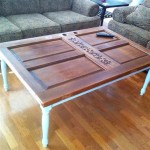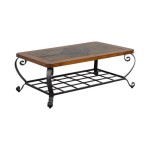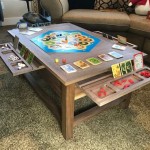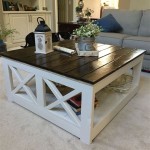```html
How To Find The Center Of A Circular Table Top
Determining the precise center of a circular table top is a common task encountered in woodworking, furniture making, and various DIY projects. Accuracy in finding the center is crucial for tasks such as mounting table legs, installing lazy Susans, or creating concentric designs. This article will outline several methods for accurately locating the center of a circular table top, employing readily available tools and mathematical principles.
The challenge arises from the absence of pre-existing markers on the table top indicating the center. The diameter, which is a line passing through the center and connecting two points on the circumference, is a fundamental concept in locating the center. Multiple diameters, intersecting at a single point, will always define the center of the circle. The techniques described below leverage this principle to achieve accurate center finding.
Method 1: The Chord Bisection Method
The chord bisection method is a geometrically sound and relatively simple technique. A chord is a straight line segment whose endpoints both lie on the circle's circumference. This method involves drawing two chords and then constructing perpendicular bisectors for each. The point where these bisectors intersect is the center of the circle.
Step 1: Draw the First Chord. Using a straightedge or ruler, draw a straight line across the circular table top, ensuring that both ends of the line end on the edge of the circle. The exact length or position of this chord is not critical at this stage. The line does not need to pass through what one might perceive as the center; any chord will work.
Step 2: Find the Midpoint of the First Chord. Measure the length of the chord you just drew. Divide this length by two to find the midpoint. Mark this midpoint precisely on the chord. Accuracy in this measurement is crucial for the effectiveness of the method.
Step 3: Draw the Perpendicular Bisector of the First Chord. A perpendicular bisector is a line that passes through the midpoint of the chord and is perpendicular to it (forming a 90-degree angle). To ensure accuracy, use a set square or a protractor to draw a line that is precisely perpendicular to the chord at the marked midpoint. Extend this bisector line across the table top, ideally reaching the opposite edge of the circle.
Step 4: Draw the Second Chord. Repeat Step 1, drawing a second chord across the table top. It is important that this second chord is not parallel to the first chord. A significant angle between the two chords will improve the accuracy of the final result.
Step 5: Find the Midpoint of the Second Chord. Repeat Step 2, measuring the length of the second chord and marking its midpoint with precision.
Step 6: Draw the Perpendicular Bisector of the Second Chord. Repeat Step 3, constructing a perpendicular bisector to the second chord at its midpoint. Use a set square or protractor to ensure a precise 90-degree angle. Extend this bisector line until it intersects with the first bisector line.
Step 7: Identify the Center. The point where the two perpendicular bisectors intersect is the center of the circular table top. Mark this point clearly. This point represents the true center of the circle.
The chord bisection method provides a relatively accurate way to find the center without specialized tools. The accuracy depends largely on the precision with which the chords are measured and the perpendicular bisectors are drawn. Using sharp pencils and accurate measuring tools is essential for optimal results.
Method 2: Using a Compass and Straightedge
This method, rooted in classical geometry, also relies on constructing intersecting lines to pinpoint the center, but utilizes a compass in addition to a straightedge. The compass allows for creating arcs that define the perpendicular bisectors with greater ease and potentially higher accuracy compared to direct measurement.
Step 1: Draw the First Chord. As in the previous method, use a straightedge to draw a chord across the circular table top. The position and length are not critical, but ensuring it terminates precisely on the circumference is important.
Step 2: Construct the Perpendicular Bisector Using a Compass. Place the compass point on one end of the chord and adjust the compass width to be more than half the length of the chord. Draw an arc that extends above and below the chord. Without changing the compass width, place the compass point on the other end of the chord and draw another arc that intersects the first arc in two places. These intersections define points that lie on the perpendicular bisector.
Step 3: Draw the First Perpendicular Bisector. Use a straightedge to draw a line connecting the two points where the arcs intersected. This line is the perpendicular bisector of the first chord and passes through the center of the circle. Extend the line across the table top.
Step 4: Draw the Second Chord. Draw a second chord across the table top that is not parallel to the first chord. The angle between the two chords should be significant to improve accuracy.
Step 5: Construct the Second Perpendicular Bisector Using a Compass. Repeat step 2, placing the compass point on each end of the second chord and drawing arcs that intersect. Maintain the same compass width for both arcs.
Step 6: Draw the Second Perpendicular Bisector. Use a straightedge to connect the two points where the arcs for the second chord intersected. This line is the perpendicular bisector of the second chord.
Step 7: Identify the Center. The point where the two perpendicular bisectors intersect is the center of the circular table top. Mark this point. The precision of this method hinges on the consistent compass radius and the accuracy of drawing the connecting line between the arc intersections.
The advantage of using a compass is that it avoids direct measurement of the chord, reducing the potential for error associated with ruler readings. The intersecting arcs inherently define the perpendicular bisector with a high degree of accuracy, making this a reliable method.
Method 3: The Right Triangle Corner Method (Using a Set Square or Similar Tool)
This method utilizes the property that any angle inscribed in a semicircle is a right angle. By placing the corner of a right-angled tool (like a set square or a large drafting triangle) on the circumference of the circle and aligning its sides with the edge, one can create a diameter of the circle.
Step 1: Position the Right-Angled Tool. Place the corner of the right-angled tool (90-degree angle) anywhere on the circumference of the circular table top. Ensure that both sides of the right angle touch the edge of the circle.
Step 2: Mark the Points Where the Sides Intersect the Circle. Carefully mark the two points on the circumference where the sides of the right angle touch the edge of the table top. These two points define the endpoints of a diameter.
Step 3: Draw the First Diameter. Use a straightedge to draw a straight line connecting the two marked points. This line is a diameter of the circular table top and passes through its center.
Step 4: Repeat the Process to Draw a Second Diameter. Reposition the right-angled tool at a different location on the circumference of the circle. Again, ensure that the corner of the right angle is on the circumference and both sides touch the edge. Mark the points where the sides of the right angle intersect the circle and draw a second diameter connecting these points. This second diameter should not be parallel or coincide with the first diameter. Changing the location significantly will improve accuracy.
Step 5: Identify the Center. The point where the two diameters intersect is the center of the circular table top. Mark this point. This method's accuracy depends on the precision with which the right angle is positioned on the circumference and the diameters are drawn.
This method is efficient when a reliable right-angled tool is available. The principle of the inscribed right angle ensures that each line drawn is a true diameter, leading to an accurate determination of the center. The larger the right triangle used (i.e., a longer set square), the easier it will be to position accurately against the edge of the tabletop.
Each of these methods provides a reliable way to determine the center of a circular table top. The choice of method will depend on the available tools, the desired level of accuracy, and the specific requirements of the project. Regardless of the method chosen, careful measurements and precise execution are key to obtaining an accurate result.
```
How To Find The Center Of A Circle 3 Easy And Quick Ways

Set Or Change Table Properties Microsoft Support

Set Or Change Table Properties Microsoft Support

Find The Center Of A Circle 3 Easy And Quick Ways

Set Or Change Table Properties Microsoft Support

Set Or Change Table Properties Microsoft Support

Word Move Table Freely 2024

Of A Circle Gcse Maths Steps Examples Worksheet

Circle Calculator
Equation Of A Circle Gcse Maths Steps Examples
Related Posts








